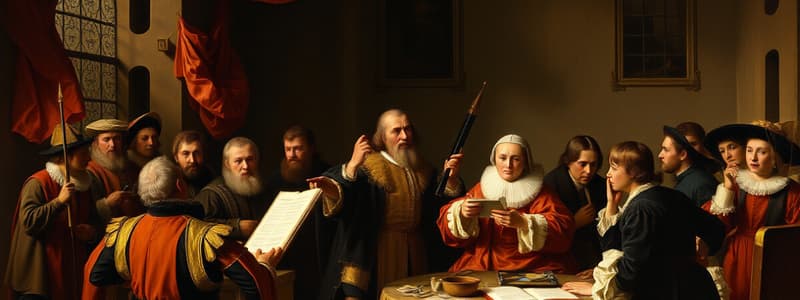Podcast
Questions and Answers
What was the primary concern regarding Mary’s gender in relation to the Wyatt Rebellion?
What was the primary concern regarding Mary’s gender in relation to the Wyatt Rebellion?
- It isolated her from political alliances.
- It increased support for the Spanish marriage.
- It threatened the Tudor dynasty's stability. (correct)
- It limited her ability to govern effectively.
What action did the House of Commons take in November 1553 regarding Mary's marriage?
What action did the House of Commons take in November 1553 regarding Mary's marriage?
- They actively supported the marriage.
- They proposed a different marriage alliance.
- They petitioned her not to marry Philip. (correct)
- They revolted against the Privy Council.
What was the public's reaction to the arrival of Spanish negotiators for the marriage treaty?
What was the public's reaction to the arrival of Spanish negotiators for the marriage treaty?
- They greeted them with celebration.
- They expressed sorrow and discontent. (correct)
- They demanded immediate discussions.
- They remained indifferent and uninterested.
What were the motivations for the cabal of conspirators that emerged in late 1553?
What were the motivations for the cabal of conspirators that emerged in late 1553?
Which significant historical figures were part of the conspirators opposing the Spanish marriage?
Which significant historical figures were part of the conspirators opposing the Spanish marriage?
What legislation confirmed Mary’s marriage treaty with Philip in April 1554?
What legislation confirmed Mary’s marriage treaty with Philip in April 1554?
What was a significant historical comparison made regarding public sentiment towards Spanish marriages?
What was a significant historical comparison made regarding public sentiment towards Spanish marriages?
What was the underlying reason for the discontent regarding Mary’s marriage to Philip?
What was the underlying reason for the discontent regarding Mary’s marriage to Philip?
What was one of the primary grievances that motivated Wyatt and his rebels?
What was one of the primary grievances that motivated Wyatt and his rebels?
Which of the following best describes a factor that caused the rebellion?
Which of the following best describes a factor that caused the rebellion?
What effect did John Proctor's Historie of Wyates Rebellion have on understanding the rebels' motivations?
What effect did John Proctor's Historie of Wyates Rebellion have on understanding the rebels' motivations?
How many simultaneous mass-uprisings were planned by the conspirators?
How many simultaneous mass-uprisings were planned by the conspirators?
Who effectively led the uprising in Kent during the rebellion?
Who effectively led the uprising in Kent during the rebellion?
Which strategy did Wyatt utilize to rally support among the rebels?
Which strategy did Wyatt utilize to rally support among the rebels?
What was a significant error made by Wyatt during his campaign?
What was a significant error made by Wyatt during his campaign?
What was Mary’s response to the threat of the rebellion as they approached London?
What was Mary’s response to the threat of the rebellion as they approached London?
What was the outcome for the majority of the rebels following the failed plot?
What was the outcome for the majority of the rebels following the failed plot?
What role did the Imperial ambassador Simon Renard play in the rebellion?
What role did the Imperial ambassador Simon Renard play in the rebellion?
What was a contributing factor to the failure of rebellion before it began?
What was a contributing factor to the failure of rebellion before it began?
What was one consequence of Mary not calling for Imperial troops during the uprising?
What was one consequence of Mary not calling for Imperial troops during the uprising?
Which notable individuals faced execution alongside Wyatt after the rebellion?
Which notable individuals faced execution alongside Wyatt after the rebellion?
What was the main focus of the rebels’ grievances regarding Mary and her policies?
What was the main focus of the rebels’ grievances regarding Mary and her policies?
What was primarily responsible for the instability during Mary’s reign?
What was primarily responsible for the instability during Mary’s reign?
Which rebellion posed the greatest threat to the monarchy during Mary’s reign?
Which rebellion posed the greatest threat to the monarchy during Mary’s reign?
How did Mary’s gender influence the perception of her reign?
How did Mary’s gender influence the perception of her reign?
What was a motivation behind the Kent rebels involved in the Wyatt rebellion?
What was a motivation behind the Kent rebels involved in the Wyatt rebellion?
What role did the Spanish marriage play in the instability of Mary’s reign?
What role did the Spanish marriage play in the instability of Mary’s reign?
Which statement best describes the outcomes of the responses to the rebellion against Mary?
Which statement best describes the outcomes of the responses to the rebellion against Mary?
What was one of the consequences of Northumberland capturing Mary during her escape?
What was one of the consequences of Northumberland capturing Mary during her escape?
How did early succession plans for Edward impact perceptions of Mary’s reign?
How did early succession plans for Edward impact perceptions of Mary’s reign?
Flashcards are hidden until you start studying
Study Notes
Overview of the Wyatt Rebellion
- Occurred in January 1554, sparked by objections to Mary I's marriage to Philip of Spain.
- Historians debate the extent of the rebellion's threat and its underlying causes, particularly relating to gender and religion.
Context of the Marriage Proposal
- Mary ignored House of Commons petition against her marriage in November 1553.
- Proclamation of marriage in January 1554, treaty ratified by Act of Parliament in April 1554.
- Public reaction to the Spanish marriage was largely negative, with reports of sorrow upon the arrival of Spanish negotiators.
Political and Social Opposition
- Bourbon fears arose concerning foreign dominance due to Mary's gender and marriage.
- Key conspirators included Sir Thomas Wyatt, Sir Peter Carew, Sir James Croft, and the Duke of Suffolk, all connected to the former Tudor administrations.
- Competing historical interpretations include factional grievances and concerns over foreign control versus issues of religious discontent.
Religious Underpinnings
- Wyatt was a vocal evangelical opposed to Mary's Catholic restoration; conspirators had connections to reformed religion.
- Evidence of religious motives primarily comes from government sources, raising questions about objectivity.
- The rebellion included economic grievances tied to the decline of the cloth industry.
Rebellion Plans and Execution
- Planned uprisings were to occur simultaneously across Kent, Devon, Herefordshire, and Leicestershire.
- Failed to maintain secrecy; key informant Courtenay revealed details to the queen's advisors, prompting early defensive measures.
- Miscalculations by the conspirators led to failures in the uprising, notably in locations outside Kent.
Wyatt's March to London
- Wyatt garnered 2,000-3,000 supporters by appealing to xenophobia and local economic dissatisfaction.
- The aged Duke of Norfolk's forces defected, intensifying the rebellion's threat as Wyatt's men approached London.
- Wyatt’s indecision and failure to act swiftly allowed the Privy Council to prepare defenses effectively.
Mary's Response and Rebellion Outcome
- Mary took a decisive role, appealing to her citizens from the Guildhall, presenting a maternal image to rally support.
- Wyatt's forces were ultimately unsuccessful; strong defenses and Mary's refusal to flee played pivotal roles.
- After rebellion cessation, the mercy shown towards rebels (only 90 executed) indicated a precarious royal position.
Assessment of Gender’s Role in Stability
- Discussion on whether Mary’s gender intrinsically contributed to instability.
- Subversion of the succession due to her gender was speculated but linked more to the context of religious beliefs and exclusion from power.
- Spanish marriage fostered xenophobia, increasing fears of foreign control attributed to Mary being a woman, which differed from earlier royal marriages.
Conclusion on the Rebellion's Seriousness
- The Wyatt Rebellion is considered the most significant threat of Mary's reign due to its potential to result in her removal.
- It highlighted the fragility of monarchical control, with public opinion and noble support hanging in the balance.
- The monarchy's weakness was evident in the aftermath, particularly as fears of Mary’s gender combined with political motivations contributed to unrest.
Studying That Suits You
Use AI to generate personalized quizzes and flashcards to suit your learning preferences.




